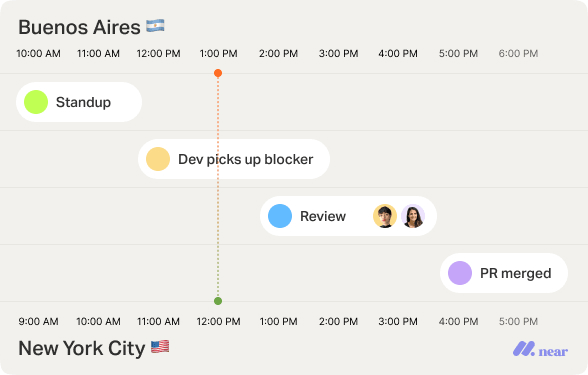Key Takeaways:
- Forward-thinking CTOs are moving away from dev agency models to building dedicated LatAm engineering teams—gaining engineers who understand their product deeply, build institutional knowledge over time, and participate as true team members rather than third-party contractors with divided loyalties.
- This team-building approach yields measurable advantages: faster hiring cycles, significantly longer retention rates compared to US-based engineers, and real-time productivity that accelerates product development.
- CTOs are choosing LatAm developers over teams in India or the Philippines because Latin America's time zone alignment with the US enables real-time collaboration and eliminates the productivity barriers created by 12+ hour communication delays.
There’s a shift happening inside some of the smartest mid-size and startup tech companies in the US.
Forward-thinking CTOs aren’t scrambling to fill seats. They’re building their teams with intention. And they’re doing it with top-tier Latin American talent.
While their competitors stay stuck in reactive mode, juggling unreliable contractors and bloated dev agencies, these leaders are quietly assembling high-performing, full-time teams who work in their time zone, grow with their product, and help move the business forward.
From Short-Term Patch to Long-Term Strategy
In the early days of remote outsourcing, the playbook was simple: when US talent got too expensive or hard to find, go offshore. Everyone looked to countries like India or the Philippines for quick-turn, low-cost contract help.
It worked—until it didn’t.
Working across up to 12 time zones makes real-time collaboration almost impossible. Feedback loops break down. Alignment lags. And when you're always playing catch-up, your team ends up working harder just to maintain momentum.
That’s why CTOs serious about building great products are shifting strategies and moving on from these short-term patches.
Instead of renting talent from a third party and hiring talent across the globe, they’re building high-trust, high-output teams in time zones that let them actually work together. And they’re doing it in LatAm.
Why Engineering Leaders Are Hiring LatAm Talent

The appeal of Latin America isn’t just cost savings compared to the US. It’s continuity, collaboration, and culture fit.
Here’s what smart CTOs are capitalizing on:
- Workday alignment: Engineers in Argentina, Mexico, Colombia, and other LatAm countries are within 0–3 hours of US time zones. That means no more waiting overnight for a response and no 2 a.m. deploys. Projects just move faster when your whole team is awake.
- Clear, fluent communication: Many LatAm devs have worked with US-based tech companies before. They’re used to asynch and real-time workflows, agile processes, and English-speaking teams.
- Team players, not temps: The best LatAm engineers aren’t just looking for a paycheck. They want to be part of something long-term. They’re looking for stability, growth, and the chance to contribute in meaningful ways.
- Smart savings, reinvested well: We see companies saving up to 66% vs. US salaries—and instead of cutting corners, they’re using some of those savings to offer better benefits, pay top-of-market in LatAm, and retain great people longer.
Put simply, these teams run better. They ship faster. And they’re built to last.

Ditch the Dev Shops, Build a Real Team
There’s a reason many CTOs are moving away from dev agency models.
Yes, they’re convenient.
But the trade-offs pile up fast:
- Devs rotate in and out
- Communication runs through account managers
- Projects lose momentum when no one really owns the work
{{state-latam-hiring}}
What these leaders have figured out is that building a dedicated team—even if it’s remote—gives them the stability, accountability, and velocity they need to compete.
And by working directly with engineers instead of through a third party, they gain control over hiring, onboarding, and culture alignment. They’re not managing vendors. They’re not paying for “offshore support.” They’re growing their core team.
Creating a Sustainable Competitive Advantage
You won’t see these companies broadcasting their shift on LinkedIn. But the benefits are stacking up:
- Faster hiring: With partners like Near, many teams go from kickoff to signed offer in under 3 weeks.
- Longer retention: The right offers and a good culture fit can keep LatAm hires 66% longer than typical US peers.
- Real-time productivity: When everyone works the same hours, blockers are resolved sooner, and products move forward without delay.
These CTOs aren’t just saving money. They’re buying back time, reducing churn, and building a hiring system that scales with their business.
They’re partnering with recruiters who know the LatAm talent market, understand local comp expectations, and have a pulse on what top engineers want from their next role.
Meanwhile, their competitors are still:
- Cycling through Upwork freelancers
- Trying to manage 12-hour time zone gaps
- Getting burned by dev agencies with high turnover
What Winning Looks Like
When you shift from outsourcing to team-building, everything changes:
- You get developers who understand your product and your customers, not just your backlog.
- You build institutional knowledge that lasts beyond the next project.
- You create a talent engine that scales with you, not one that resets every time a contract ends.
It’s not a flashy move. But it’s the one that works.
And you don’t need to figure it out on your own.
How Near Helps CTOs Navigate LatAm Hiring Without the Hassle
.webp)
At Near, we help US engineering leaders build real teams in Latin America. We handle the sourcing, vetting, and assessment—so you get engineers who match your stack, your pace, and your team culture.
Whether you want to handle payroll yourself or have us run it end-to-end, we flex to what works for you. And if it doesn’t work out, we replace the hire—fast.
This isn’t about hiring cheaper. It’s about hiring better.
Get real teammates, real-time comms, and real savings over hiring in the US.
Stop settling for third-party devs who rotate out. Start building a team of engineers who grow with your product and help drive it forward.
Book a free consultation call today.













.png)






%20(1).png)
%20(1).png)
